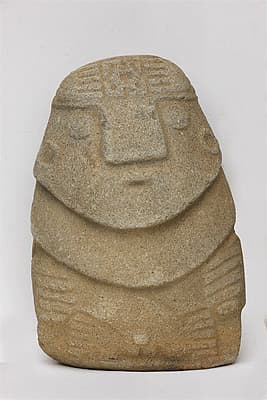RECUAY culture Northern highlands 100 – 650 AD
Male figure with crossed legs 100-650 AD igneous stone76.0 (h) x 50.0 (w) x 32.0 (d) cm Museo Larco, Lima Photograph: Daniel Giannoni
Recuay stone sculptures were typically rigid, abstracted warrior figures, signalling the martial nature of the culture. Stone warriors often carried clubs and spoils of war, in the form of severed heads. Figures were usually shown seated, with legs crossed and arms wrapped around the waist, evoking a mummy bundle. The flat face reminds us of masks that adorned the dead, features which suggest the carvings were effigies of dead ancestors.
Recuay stone sculptures were typically rigid, abstracted warrior figures, signalling the martial nature of the culture. Stone warriors often carried clubs and spoils of war, in the form of severed heads. Figures were usually shown seated, with legs crossed and arms wrapped around the waist, evoking a mummy bundle. The flat face reminds us of masks that adorned the dead, features which suggest the carvings were effigies of dead ancestors.
Recuay stone sculptures were typically rigid, abstracted warrior figures, signalling the martial nature of the culture. Stone warriors often carried clubs and spoils of war, in the form of severed heads. Figures were usually shown seated, with legs crossed and arms wrapped around the waist, evoking a mummy bundle. The flat face reminds us of masks that adorned the dead, features which suggest the carvings were effigies of dead ancestors.


